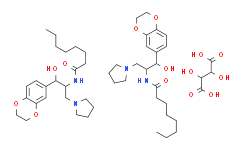| Cas No.: | 928659-70-5 |
| Chemical Name: | Eliglustat tartrate |
| Synonyms: | eliglustat tartrate;N-[(1R,2R)-1-(2,3-dihydro-1,4-benzodioxin-6-yl)-1-hydroxy-3-pyrrolidin-1-ylpropan-2-yl]octanamide,(2R,3R)-2,3-dihydroxybutanedioic acid;Eliglustat (hemitartrate) |
| SMILES: | CCCCCCCC(N[C@H](CN1CCCC1)[C@@H](C2=CC=C(OCCO3)C3=C2)O)=O.CCCCCCCC(N[C@H](CN4CCCC4)[C@@H](C5=CC=C(OCCO6)C6=C5)O)=O.O=C(O)[C@H](O)[C@@H](O)C(O)=O |
| Formula: | C50H78N4O14 |
| M.Wt: | 959.188 |
| Sotrage: | 2 years -20°C Powder, 2 weeks 4°C in DMSO, 6 months -80°C in DMSO |
| Description: | Eliglustat hemitartrate is an specific, potent and orally active glucocerebroside synthase inhibitor with an IC50 of 24 nM. |
| In Vitro: | Eliglustat tartrate shows good potency with an IC50 of 24 nM and specificity against the target enzyme[1].Incubating K562 or B16/F10 cells for 72 h with increasing amounts of Genz-112638 (0.6-1000 nM) results in a dose-dependent reduction of cell surface levels of both GM1 and GM3. The mean IC50 value for inhibiting the cell surface presentation of GM1 in K562 cells was 24 nM (range 14-34 nM) and that for GM3 in B16/F10 cells was 29 nM (range 12-48 nM)[1]. |

 DC Chemicals' products qualify for U.S. tariff exemptions. We guarantee no price increases due to customs duties and maintain stable supply, continuing to deliver reliable research solutions to our American clients.
DC Chemicals' products qualify for U.S. tariff exemptions. We guarantee no price increases due to customs duties and maintain stable supply, continuing to deliver reliable research solutions to our American clients.





















